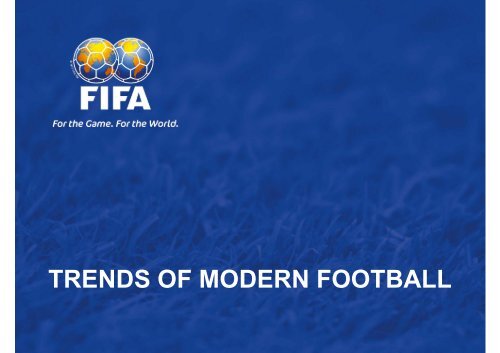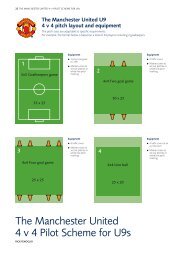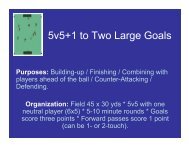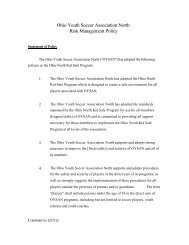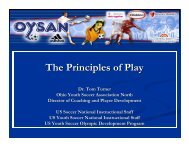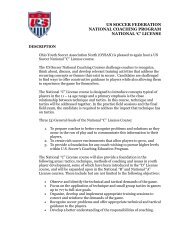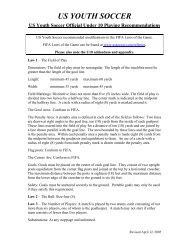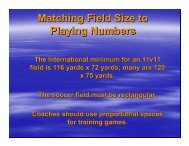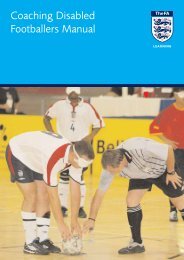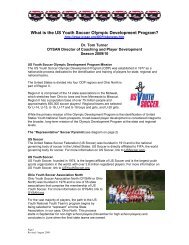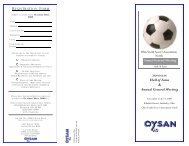trends of modern football - Oregon Youth Soccer Association
trends of modern football - Oregon Youth Soccer Association
trends of modern football - Oregon Youth Soccer Association
Create successful ePaper yourself
Turn your PDF publications into a flip-book with our unique Google optimized e-Paper software.
TRENDS OF MODERN FOOTBALL
ANALYSIS OF THE GAME
Analysis <strong>of</strong> elite <strong>football</strong>Analysis <strong>of</strong> elite <strong>football</strong>Impact onpractice and trainingfor playersPr<strong>of</strong>ile <strong>of</strong> anelite player
Analysis <strong>of</strong> elite <strong>football</strong>”The game is going to become faster with less spaceand less time.” Gaby ROBERT, 1986“Players have to react faster. Every movement, everyaction happens faster. Think faster, act faster, thisis the <strong>football</strong> <strong>of</strong> the future.”Valery LOBANOVSKY, 1996“The evolution <strong>of</strong> <strong>football</strong> essentially involves threeelements: speed, space and technical and physicalstrength.”GérardHOULLIER, 2002“In ten years, the game will have moved on. It will beFASTER, STRONGER and played at a HIGHERPACE with more ingenious tactics.”Petr CECH, 2007
Analysis <strong>of</strong> elite <strong>football</strong>Relationship between space & time: key element <strong>of</strong> <strong>modern</strong> <strong>football</strong>Space: make, use and close down space (width and depth) Reducedistances between team linesConcept <strong>of</strong> width and depth <strong>of</strong> playTime: be faster than the regrouping <strong>of</strong> the defenceRetreat <strong>of</strong> defence: 5 to 6 m/s
Analysis <strong>of</strong> elite <strong>football</strong>“The most important moment in the game today iswhen the ball is won or lost.”Gérard Houllier
Analysis <strong>of</strong> elite <strong>football</strong>Goalscoring 2006World CupChampions LeagueOpen play 72% (84) 72% (205)Set pieces 28% (33) 28% (80)Total 117 285
Analysis <strong>of</strong> elite <strong>football</strong>Set piecesGoals scored from set pieces (30%)Corner kickFree kick (direct)Free kick (indirect)Penalty kickThrow-in
The role <strong>of</strong> set pieces in elite <strong>football</strong>1614121086420penaltykickdirectfree kickindirectfree kickcornerkick30% <strong>of</strong> goals are scored fromset pieces.Result:It is essential to practice setpieces from both a technicaland a tactical perspective.
The role <strong>of</strong> set pieces in elite <strong>football</strong>“Free-kick specialists are vital. The <strong>modern</strong> ball hasalso had an impact on set pieces.”Claude PUELOSC Lille
Analysis <strong>of</strong> elite <strong>football</strong>Open playOpen play: controlled built-up attacks or accelerated attacks3 to 4 controlled built-up attacks for 1 accelerated attackbut …70% <strong>of</strong> goals scored from open play are the result <strong>of</strong> acceleratedattacks or counter-attacks30% are the result <strong>of</strong> controlled built-up attacks“A strong team has the capacity to alternate controlled build-upplay with collective accelerated collective attacks.”70% <strong>of</strong> shots come at the end <strong>of</strong> sequences <strong>of</strong> 1 to 3 passes …90% <strong>of</strong> shots come at the end <strong>of</strong> sequences <strong>of</strong> 6 passes or less.
Analysis <strong>of</strong> elite <strong>football</strong>Open playMatch: 100 to 120 attacking plays10 to 15 threats on goal3 to 6 clear goalscoring opportunitiesShots: 20 to 25 shots per match for both teams1 goal from every 4 to 5 shots on goalSet pieces : 30% <strong>of</strong> total goals scoredFirst goal scored: 75% wins, 17% draws, 8% defeatsOne-on-one situations: The team that wins most one-on-onesituations (attack/defence) in the key areas wins the match.
Analysis <strong>of</strong> elite <strong>football</strong>Open play“We won all one-onon-one-situations, , that’s s why wewon the match.”Sir Alex FERGUSON
Analysis <strong>of</strong> elite <strong>football</strong>Open playControlled built-up up attacksTactical situation: : Opposing defensive block in positionObjective: : Make space or play throughballsHow?: - Switch play from one side to the other to create width- Collective control <strong>of</strong> the ball by multiple passes in orderto:- create space in the middle <strong>of</strong> the pitch for 1-212 or 1-2-31breakthroughs- Switch play out wide for a cross- Set up a long-range shot- Individual initiative and penetration
Analysis <strong>of</strong> elite <strong>football</strong>Open play“Snake” strategySlow tempo Acceleration + PenetrationPassing quality(accuracy, tempo, throughballs)IndividualCollective
Analysis <strong>of</strong> elite <strong>football</strong>Open play“Delivery is everything.”Sir Alex FERGUSON“The game starts one way, thenchanges and usually finishesanother way.”Marcello LIPPI
Analysis <strong>of</strong> elite <strong>football</strong>Open playQUICK BREAK40% <strong>of</strong> goals from open play were the result <strong>of</strong> a quick breakClassic: : The ball is played long to one or two attackers, who are in alarge space and against few defendersCollective: : A group <strong>of</strong> players attack at pace with direct, fluidcombination play (e.g.: Arsenal)Solo: An individual action, direct running with the ball and sol<strong>of</strong>inishingPressing: : regain the ball early by putting collective pressure on theopponent
Analysis <strong>of</strong> elite <strong>football</strong>Open playQUICK BREAKCapacity to accelerate into an attack as soon as the ball is regained“The most important moment in the game today is when the ball iswon or lost.” Gérard HOULLIERModern training: look for a long first passChallenge: Anticipate the regrouping <strong>of</strong> opponents’ defenceObjective: Play the ball up front when possession is regained
Analysis <strong>of</strong> elite <strong>football</strong>Open play“Act quickly and effectively, avoid anything thatcould slow play down.”Carlo ANCELOTTI
Analysis <strong>of</strong> elite <strong>football</strong>Open play“You must capitalise on the space in front <strong>of</strong>you.”Sir Alex FERGUSON“We need to play in the depths wheneverpossible.”Ottmar HITZFELD“The quick transition is the most importantaspect – quickly restructuring to defend orexploiting the opponent with speed whenthe ball is regained.”José MOURINHO
Number <strong>of</strong> passes leading up to a goal60504030201006 passesor moreLess than4 passesImpact on tactical training:2 types <strong>of</strong> attacking plays:• Quick attacking play ( < 10’’)• Controlled built-up attacking plays(>15’’)The variation between controlled builtupattacking play and quick attackingplay is what makes a team successful.Players need to have a tacticalunderstanding in order to identify theright moment and area.
The decisive pass50454035302520151050CrossesShortpassesLongpassesOthersCROSSES and SHORT PASSES are themost effective ways to score.50% <strong>of</strong> goals are scored from a cross (1out <strong>of</strong> two goals).Result:- Work on speed- Work on crosses and receiving theball- Work on tactics to exploit the flanks
Effective playing time706050403020Effective playingtime (min.)100WorldCup 90WorldCup 94WorldCup 98EURO00WorldCup 02
Effective playing timeIn 1990, the average effective playing time was 55minutes. At EURO 2000, it was 68 minutes.Result:for the player: excellent stamina requiredfor the coach: high tempo during training sessions, longer or morefrequent sessions
GoalscoringShooting zones4540353025201510505.50mpenaltymark16.50m> 16.50mKey shooting zone:79% <strong>of</strong> goals are scored frominside the penalty areaBUT…63% <strong>of</strong> goals are scored betweenthe goal line and the penalty markResult:Work on shooting from the keyshooting zones
GoalscoringNumber <strong>of</strong> touches per player and per goal504540353025201510501 touch2 touches3 touches4 touches5 touchesand more87% <strong>of</strong> goals are scored after 3touches at most.Consequence:Work on shooting from inside thepenalty area after as few touchesand after as short a time aspossible
The requirements <strong>of</strong> elite <strong>football</strong>PHYSICALSTRENGTHUNDERSTANDINGOF GAMETIMINGMENTALSTRENGTH
“Talent wins games, but teamworkand intelligence winchampionships.”Michael JORDAN
Psychological requirementsMENTAL STRENGTH• Competitiveness / winning mentality / resistance to stress / selfcontrol/ confidence• Commitment / motivation• Ability to push oneself / fighting spirit• Unburdened / focused / disciplined• Desire to improve
Psychological requirements“Many fail because they are inhibited when underpressure.”Arsène WENGER
Tactical requirementsTACTICAL UNDERSTANDING• Ability to read the game and make the right decision (timing)• Ability to adapt effectively to game situations• Ability to adapt to different tactical set-ups and systems duringthe game• Versatility / discipline• Ability to play an attacking game• Ability to put the opponent under pressure in terms <strong>of</strong> time andspace
“My great gift was my ability to readthe game.”Michel PLATINI“The very good teams can changeeffectively during the game.”Jozef VENGLOS
Technical requirementsKEY TO SUCCESS• Technique adapted to a game with little time and space: qualityand diversity• Combination <strong>of</strong> technique and physical strength• Range and quality <strong>of</strong> ball control while moving• Ball control / passing• Quality and range <strong>of</strong> shooting (shooting and long passing)• Tricks / dribbling / versatility / position-specific skills• Strength in one-on-one situations (on the ground and in the air)• Ability to keep possession <strong>of</strong> the ball when under pressure
“In Brazil, we believe in flair, possession and joy.”Carlos Alberto PARREIRA
Physical requirementsFOOTBALLER : MASTER OF TEMPO• Ability to produce intensive physical efforts : speed / power /dynamism• Ability to adapt to intensive and repeated changes <strong>of</strong> tempo :resistance• Stamina / playing capacity• Ability to recover quickly• Skill and strength in the challenge• Coordination / flexibility / technique
Physical requirements“Be ready to play 60 to 70 matches per season.”José MOURINHO
Impact on trainingTechnique: more competitive technique• Work with opponents in match conditions• Intensity• Small spaces• One-on-one situations• Long runs• Outnumbered situations• Under pressure• Creativity and tricks• Individual initiative
Impact on trainingFitness• Longer running distances• More intensive technical drills• Resistance to pressure and physical impact• Work in outnumbered situations• Increase aerobic capacity to improve recovery• Develop maximum aerobic power• Interval training• Improve muscular power (strength and speed)• Improve coordination (technique)
Impact on trainingTactics• Individual tactical understanding• Collective tactical versatility• Adaptability to different systems and set-ups• Work on versatility• Rapid transition from attack to defence and vice versa• Ability to see and to be seen between two opponents• Play with movement (stance, calls, support)• Work on set pieces• Responsibility / adaptability / initiative
Elite players• Height: 181cm• Weight: 74kg• VO2Max: 60 to 65ml• Sprint 10m: 1’’78• Sprint 20m: 2’’89• Sprint 60m: 7’’43• Jumping height: 63cm• Great speed <strong>of</strong> movement andrunning•Dynamism• Technical skills• Muscular power• Ability to recover quickly• Ability to repeatedly produce shortand intensive efforts• Tactical understanding• Mental strength and self control


